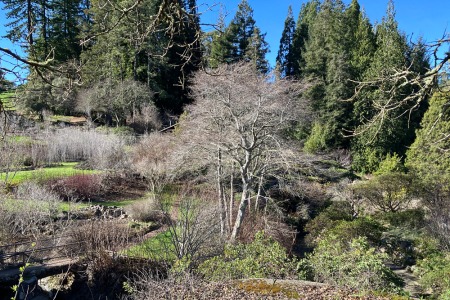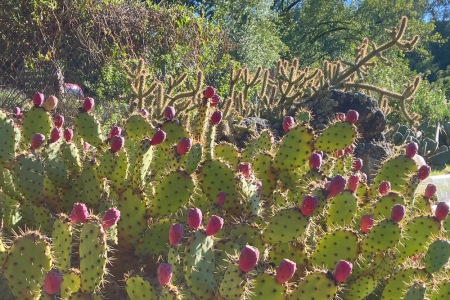There are two great gardens in the hills above Berkeley. The UC Berkeley Botanical Garden, in Strawberry Canyon above the campus, has plants from all over the world. I’m here to talk about the other one: the Regional Parks Botanic Garden. It’s in Wildcat Canyon, hidden over the ridge in Tilden Regional Park, and focuses exclusively on California.
OK, the one garden is “botanical” and the other is “botanic.” In my mind the difference is subtle but noteworthy, like the distinction between “geological” and “geologic”: the shorter word has an air-quotes connotation of something scientific or scholarly. The Botanic Garden carries out its mission vigilantly, and wherever you’ve been in California, from the redwoods to the desert to the volcanoes to the coast, the garden grows plants from that place within its ten acres. That takes a good understanding of geologic matters.
Winter is a special time to visit. All the deciduous plants are bare with their structures on display.
That’s when to see the flowering manzanitas. California has dozens of species of Arctostaphylos in every part of the state. Last week, in February, this manzanita was on the late side of bloom while others were hitting their stride. Manzanitas get many California bee species through the winter when nothing else blooms.
The garden has local plants, like the redwoods in the river gorge at the north end, and plenty of smaller ones in their own plots. These are fun to spot in the woods.
The garden’s website points out highlights for every month of the year.
The gardeners use every trick to make Mojave Desert species happy in the cool, wet hills.
They can do a lot by controlling sun exposure, drainage and ground covers. I saw several examples of their geological thoughtfulness, too.
The native soil is moist and fertile, derived from mudstones and volcanic rocks. To grow alpine and desert plants here, it’s replaced with much leaner soils. Also, California has scores of unique species that thrive in serpentine soil, something alien to Tilden Park (lots of it in Redwood Park, though).
The garden’s visitor center has a good exhibit of serpentine and related rocks, with big hand specimens you can heft and peer at. (I wrote about it here during the great serpentine kerfuffle.)
Here a Sierra Nevada species is being raised on decomposed granite from its home locality.
This interesting plot is new since my last visit: an accurate miniature of a Sierran slope where the rock is not granite, but ancient slate and sandstone in what geologists call roof pendants. It’s a specific and widespread habitat throughout the Sierra Nevada.
The slabs of stone are tilted and stacked to reproduce the upturned layers of an outcrop, surrounded by slate rubble. This same habitat is found in the “tombstone rock” country of the foothills, pastureland that can’t be plowed because the slate protrudes in sharp blades from the ground.
I sought out the Botanic Garden staff to learn more. They love all kinds of questions. They said the rocks were quarried in the high Sierra and assembled here, using boulders to help hold the slices together. It’s taken them three years. To reproduce the chemical character of the scant soil between the stone layers, they placed an order for expanded shale from a Utah supplier because the expanded clay offered by nearer firms wouldn’t have the right chemistry.
I was told that by tweaking the recipe they can customize each crack to suit the exact needs of the plant they put in it. If you like the rock garden in the Gardens at Lake Merritt I wrote about three years ago, you’ll love watching this geological feature as the years and seasons proceed.
PS: I told about a great spot to enjoy our local manzanitas a few years ago, a real “bee-loud glade.”








Leave a reply